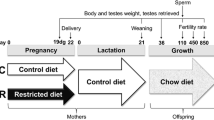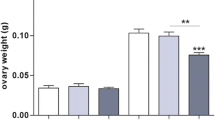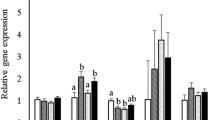Abstract
Purpose:
Increasing evidence exists that maternal obesity (MO) and overnutrition during pregnancy and lactation have long-lasting consequences for progeny metabolism, cardiovascular and endocrine function. Data on effects of MO on offspring reproduction are limited. We hypothesized that MO during pregnancy and lactation in founder F0 rat mothers would increase testicular and sperm oxidative stress (OS) and adversely impact male fertility in their F1 offspring.
Methods:
We induced pre-pregnancy MO by feeding F0 females a high-fat diet from weaning through pregnancy and lactation. After weaning, all F1 rats ate control (C) diet. We determined serum testosterone, malondialdehyde (MDA), reactive oxygen species (ROS) and superoxide dismutase (SOD) and glutathione peroxidase (GPx) activity in F1 testes and sperm at postnatal days (PNDs) 110, 450 and 650.
Results:
At PNDs 450 and 650, MO offspring had lower luteinizing hormone while testosterone levels were lower at all ages. Testicular MDA and ROS concentrations and SOD and GPx activity were higher in MO F1 at all ages. Nitrotyrosine immunostaining was higher at all ages in MO F1 testes than C F1. At PNDs 450 and 650, MO F1 spermatozoa showed higher MDA concentrations and lower SOD and GPx activity with reduced sperm concentration, viability and motility, and more sperm abnormalities. Fertility rate was not affected at PND 110 but was lower in MO F1 at PNDs 450 and 650.
Conclusions:
We conclude that MO during pregnancy and lactation increases F1 testicular and sperm OS leading to premature aging of reproductive capacity.






Similar content being viewed by others
References
Taylor PD, Samuelsson AM, Poston L . Maternal obesity and the developmental programming of hypertension: a role for leptin. Acta Physiol (Oxf) 2014; 210: 508–523.
Zambrano E, Nathanielsz PW . Mechanisms by which maternal obesity programs offspring for obesity: evidence from animal studies. Nutr Rev 2013; 71 (Suppl 1): S42–S54.
Williams L, Seki Y, Vuguin PM, Charron MJ . Animal models of in utero exposure to a high fat diet: a review. Biochim Biophys Acta 2014; 1842: 507–519.
Parlee SD, Macdougald OA . Maternal nutrition and risk of obesity in offspring: The Trojan horse of developmental plasticity. Biochim Biophys Acta 2014; 1842: 495–506.
Portha B, Chavey A, Movassat J . Early-life origins of type 2 diabetes: fetal programming of the beta-cell mass. Exp Diabetes Res 2011; 2011: 105076.
Ingelfinger JR, Nuyt AM . Impact of fetal programming, birth weight, and infant feeding on later hypertension. J Clin Hypertens (Greenwich) 2012; 14: 365–371.
Desai M, Beall M, Ross MG . Developmental origins of obesity: programmed adipogenesis. Curr Diabetes Rep 2013; 13: 27–33.
Sarr O, Yang K, Regnault TR . In utero programming of later adiposity: the role of fetal growth restriction. J Pregnancy 2012; 2012: 134758.
Zambrano E, Guzman C, Rodriguez-Gonzalez GL, Durand-Carbajal M, Nathanielsz PW . Fetal programming of sexual development and reproductive function. Mol Cell Endocrinol 2014; 382: 538–549.
Zambrano E, Rodriguez-Gonzalez GL, Guzman C, Garcia-Becerra R, Boeck L, Diaz L et al. A maternal low protein diet during pregnancy and lactation in the rat impairs male reproductive development. J Physiol 2005; 563: 275–284.
Zambrano E, Bautista CJ, Deas M, Martinez-Samayoa PM, Gonzalez-Zamorano M, Ledesma H et al. A low maternal protein diet during pregnancy and lactation has sex- and window of exposure-specific effects on offspring growth and food intake, glucose metabolism and serum leptin in the rat. J Physiol 2006; 571: 221–230.
Zambrano E, Martinez-Samayoa PM, Bautista CJ, Deas M, Guillen L, Rodriguez-Gonzalez GL et al. Sex differences in transgenerational alterations of growth and metabolism in progeny (F2) of female offspring (F1) of rats fed a low protein diet during pregnancy and lactation. J Physiol 2005; 566: 225–236.
Catalano PM, Presley L, Minium J, Hauguel-de Mouzon S . Fetuses of obese mothers develop insulin resistance in utero. Diabetes Care 2009; 32: 1076–1080.
Zambrano E, Martinez-Samayoa PM, Rodriguez-Gonzalez GL, Nathanielsz PW . Dietary intervention prior to pregnancy reverses metabolic programming in male offspring of obese rats. J Physiol 2010; 588: 1791–1799.
Vega CC, Reyes-Castro LA, Bautista CJ, Larrea F, Nathanielsz PW, Zambrano E . Exercise in obese female rats has beneficial effects on maternal and male and female offspring metabolism. Int J Obes (Lond) 2013. e-pub ahead of print 16 August 2013 doi:10.1038/ijo.2013.150.
Grissom N, Bowman N, Reyes TM . Epigenetic programming of reward function in offspring: a role for maternal diet. Mamm Genome 2014; 25: 41–48.
Rodriguez JS, Rodriguez-Gonzalez GL, Reyes-Castro LA, Ibanez C, Ramirez A, Chavira R et al. Maternal obesity in the rat programs male offspring exploratory, learning and motivation behavior: prevention by dietary intervention pre-gestation or in gestation. Int J Dev Neurosci 2012; 30: 75–81.
Sloboda DM, Howie GJ, Pleasants A, Gluckman PD, Vickers MH . Pre- and postnatal nutritional histories influence reproductive maturation and ovarian function in the rat. PloS One 2009; 4: e6744.
Howie GJ, Sloboda DM, Kamal T, Vickers MH . Maternal nutritional history predicts obesity in adult offspring independent of postnatal diet. J Physiol 2009; 587: 905–915.
Connor KL, Vickers MH, Beltrand J, Meaney MJ, Sloboda DM . Nature, nurture or nutrition? Impact of maternal nutrition on maternal care, offspring development and reproductive function. J Physiol 2012; 590: 2167–2180.
Hounsgaard ML, Hakonsen LB, Vested A, Thulstrup AM, Olsen J, Bonde JP et al. Maternal pre-pregnancy body mass index and pubertal development among sons. Andrology 2014; 2: 198–204.
Ramlau-Hansen CH, Nohr EA, Thulstrup AM, Bonde JP, Storgaard L, Olsen J . Is maternal obesity related to semen quality in the male offspring? A pilot study. Hum Reprod 2007; 22: 2758–2762.
Martini AC, Molina RI, Tissera A, Ruiz RD, de Cuneo MF . The impact of obesity on male reproduction: its biological significance. Exp Rev Endocrinol Metab 2013; 8: 139–148.
Aggerholm AS, Thulstrup AM, Toft G, Ramlau-Hansen CH, Bonde JP . Is overweight a risk factor for reduced semen quality and altered serum sex hormone profile? Fertil Steril 2008; 90: 619–626.
Chavarro JE, Toth TL, Wright DL, Meeker JD, Hauser R . Body mass index in relation to semen quality, sperm DNA integrity, and serum reproductive hormone levels among men attending an infertility clinic. Fertil Steril 2010; 93: 2222–2231.
Palmer NO, Bakos HW, Owens JA, Setchell BP, Lane M . Diet and exercise in an obese mouse fed a high-fat diet improve metabolic health and reverse perturbed sperm function. Am J Physiol Endocrinol Metab 2012; 302: E768–E780.
Erdemir F, Atilgan D, Markoc F, Boztepe O, Suha-Parlaktas B, Sahin S . [The effect of diet induced obesity on testicular tissue and serum oxidative stress parameters]. Actas Urol Esp 2012; 36: 153–159.
Sikka SC . Oxidative stress and role of antioxidants in normal and abnormal sperm function. Front Biosci 1996; 1: e78–e86.
Rodriguez-Gonzalez GL, Reyes-Castro LA, Vega CC, Boeck L, Ibanez C, Nathanielsz PW et al. Accelerated aging of reproductive capacity in male rat offspring of protein-restricted mothers is associated with increased testicular and sperm oxidative stress. Age (Dordr) 2014; 36: 9721.
Acer N, Sahin B, Usanmaz M, Tatoglu H, Irmak Z . Comparison of point counting and planimetry methods for the assessment of cerebellar volume in human using magnetic resonance imaging: a stereological study. Surg Radiol Anat 2008; 30: 335–339.
Liu Z, Chang Q, Xu ZL, Zhang ZG . Stereological measurement of rat's seminiferous tubule. Chin Med J 2009; 122: 2643–2646.
Villamor E, Cnattingius S . Interpregnancy weight change and risk of adverse pregnancy outcomes: a population-based study. Lancet 2006; 368: 1164–1170.
Samuelsson AM, Matthews PA, Argenton M, Christie MR, McConnell JM, Jansen EH et al. Diet-induced obesity in female mice leads to offspring hyperphagia, adiposity, hypertension, and insulin resistance: a novel murine model of developmental programming. Hypertension 2008; 51: 383–392.
Nathanielsz PW, Ford SP, Long NM, Vega CC, Reyes-Castro LA, Zambrano E . Interventions to prevent adverse fetal programming due to maternal obesity during pregnancy. Nutr Rev 2013; 71 (Suppl 1): S78–S87.
Pi-Sunyer FX . The obesity epidemic: pathophysiology and consequences of obesity. Obes Res 2002; 10 (Suppl 2): 97S–104S.
Derby CA, Zilber S, Brambilla D, Morales KH, McKinlay JB . Body mass index, waist circumference and waist to hip ratio and change in sex steroid hormones: the Massachusetts Male Ageing Study. Clin Endocrinol 2006; 65: 125–131.
Chimento A, Sirianni R, Casaburi I, Pezzi V . Role of estrogen receptors and G protein-coupled estrogen receptor in regulation of hypothalamus-pituitary-testis axis and spermatogenesis. Front Endocrinol 2014; 5: 1.
Hotaling JM, Patel Z . Male endocrine dysfunction. Urol Clin North Am 2014; 41: 39–53.
Bonavera JJ, Swerdloff RS, Leung A, Lue YH, Baravarian S, Superlano L et al. In the male brown-Norway (BN) male rat, reproductive aging is associated with decreased LH-pulse amplitude and area. J Androl 1997; 18: 359–365.
Walczak-Jedrzejowska R, Wolski JK, Slowikowska-Hilczer J . The role of oxidative stress and antioxidants in male fertility. Cent Eur J Urol 2013; 66: 60–67.
Pou KM, Massaro JM, Hoffmann U, Vasan RS, Maurovich-Horvat P, Larson MG et al. Visceral and subcutaneous adipose tissue volumes are cross-sectionally related to markers of inflammation and oxidative stress: the Framingham Heart Study. Circulation 2007; 116: 1234–1241.
Conceicao EP, Franco JG, Oliveira E, Resende AC, Amaral TA, Peixoto-Silva N et al. Oxidative stress programming in a rat model of postnatal early overnutrition—role of insulin resistance. J Nutr Biochem 2013; 24: 81–87.
Thompson LP, Al-Hasan Y . Impact of oxidative stress in fetal programming. J Pregnancy 2012; 2012: 582748.
Jarvie E, Hauguel-de-Mouzon S, Nelson SM, Sattar N, Catalano PM, Freeman DJ . Lipotoxicity in obese pregnancy and its potential role in adverse pregnancy outcome and obesity in the offspring. Clin Sci (Lond) 2010; 119: 123–129.
Poston L, Igosheva N, Mistry HD, Seed PT, Shennan AH, Rana S et al. Role of oxidative stress and antioxidant supplementation in pregnancy disorders. Am J Clin Nutr 2011; 94: 1980S–1985S.
Saben J, Lindsey F, Zhong Y, Thakali K, Badger TM, Andres A et al. Maternal obesity is associated with a lipotoxic placental environment. Placenta 2014; 35: 171–177.
Strakovsky RS, Pan YX . In utero oxidative stress epigenetically programs antioxidant defense capacity and adulthood diseases. Antioxid Redox Signal 2012; 17: 237–253.
Tarry-Adkins JL, Chen JH, Jones RH, Smith NH, Ozanne SE . Poor maternal nutrition leads to alterations in oxidative stress, antioxidant defense capacity, and markers of fibrosis in rat islets: potential underlying mechanisms for development of the diabetic phenotype in later life. FASEB J 2010; 24: 2762–2771.
Sloboda DM, Hart R, Doherty DA, Pennell CE, Hickey M . Age at menarche: Influences of prenatal and postnatal growth. J Clin Endocrinol Metab 2007; 92: 46–50.
Michalakis K, Mintziori G, Kaprara A, Tarlatzis BC, Goulis DG . The complex interaction between obesity, metabolic syndrome and reproductive axis: a narrative review. Metabolism 2013; 62: 457–478.
Doshi SB, Khullar K, Sharma RK, Agarwal A . Role of reactive nitrogen species in male infertility. Reprod Biol Endocrinol 2012; 10: 109.
Ischiropoulos H . Biological tyrosine nitration: a pathophysiological function of nitric oxide and reactive oxygen species. Arch Biochem Biophys 1998; 356: 1–11.
Savini I, Catani MV, Evangelista D, Gasperi V, Avigliano L . Obesity-associated oxidative stress: strategies finalized to improve redox state. Int J Mol Sci 2013; 14: 10497–10538.
Dennery PA . Oxidative stress in development: nature or nurture? Free Radic Biol Med 2010; 49: 1147–1151.
Stuart JA, Maddalena LA, Merilovich M, Robb EL . A midlife crisis for the mitochondrial free radical theory of aging. Longevity & healthspan 2014; 3: 4.
Agarwal A, Saleh RA, Bedaiwy MA . Role of reactive oxygen species in the pathophysiology of human reproduction. Fertil Steril 2003; 79: 829–843.
Omu AE . Sperm parameters: paradigmatic index of good health and longevity. Med Princ Pract 2013; 22 (Suppl 1): 30–42.
Aitken RJ, Baker MA . Reactive oxygen species generation by human spermatozoa: a continuing enigma. Int J Androl 2002; 25: 191–194.
Palmer NO, Bakos HW, Fullston T, Lane M . Impact of obesity on male fertility, sperm function and molecular composition. Spermatogenesis 2012; 2: 253–263.
Landry D, Cloutier F, Martin LJ . Implications of leptin in neuroendocrine regulation of male reproduction. Reprod Biol 2013; 13: 1–14.
Acknowledgements
GLR-G and LAR-Care graduate students from Doctorado en Ciencias Biomédicas, Facultad de Medicina, CI is graduate student from Doctorado en Ciencias Bioquímicas, Universidad Nacional Autónoma de México and are recipients of Consejo Nacional de Ciencias y Tecnología (CONACyT) fellowship. This work was supported by CONACyT México 155166.
Author information
Authors and Affiliations
Corresponding author
Ethics declarations
Competing interests
The authors declare no conflict of interest.
Rights and permissions
About this article
Cite this article
Rodríguez-González, G., Vega, C., Boeck, L. et al. Maternal obesity and overnutrition increase oxidative stress in male rat offspring reproductive system and decrease fertility. Int J Obes 39, 549–556 (2015). https://doi.org/10.1038/ijo.2014.209
Received:
Revised:
Accepted:
Published:
Issue Date:
DOI: https://doi.org/10.1038/ijo.2014.209
- Springer Nature Limited
This article is cited by
-
Developmental programming–ageing effects in muscle strength of obese rat offspring in a sex-dependent manner
Journal of Biosciences (2023)
-
Dietary trends and the decline in male reproductive health
Hormones (2023)
-
Association of pre-pregnancy body mass index and gestational weight gain with neonatal anogenital distance in a Chinese birth cohort
Reproductive Health (2022)
-
The Association between High Fat Diet around Gestation and Metabolic Syndrome-related Phenotypes in Rats: A Systematic Review and Meta-Analysis
Scientific Reports (2017)
-
Increase in endogenous estradiol in the progeny of obese rats is associated with precocious puberty and altered follicular development in adulthood
Endocrine (2016)




